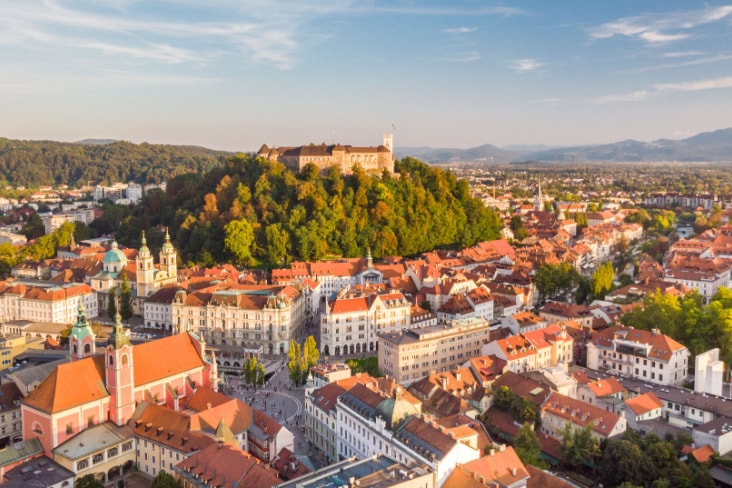From ancient stilt houses to the man who swam the Amazon River, these are the most interesting facts about Slovenia.

Fast facts
Official name: Republic of Slovenia
Population: 2.1 million
Area: 20,273 sq km
Capital city: Ljubljana
Major languages: Slovene, Croatian, Serbo-Croatian, Bosnian, Serbian
Major religions: Christianity, Islam
Time zone: UTC+1 (Central European Time)
– Source: CIA World Factbook
Interesting facts about Slovenia
1. Slovenia is a country located in central Europe bordering Austria, Croatia, Hungary and Italy.
– Source: Britannica
2. Slovenia was part of the former country of Yugoslavia until June 1991 when Slovenia, along with Croatia, seceded.
– Source: New York Times
3. Unlike other former Yugoslav states such as Croatia, Bosnia and Herzegovina or Kosovo, Slovenia’s independence came about relatively quickly and with far fewer deaths. Slovenia’s war of independence lasted just 10 days and claimed the lives of 66 people.
– Source: BBC News, New York Times

4. The European Community recognised Slovenia as an independent country in January 1992 and in May 1992, it was admitted into the United Nations as its 176th member.
– Source: New York Times
5. Slovenia means “Land of the Slavs” in Slovene.
– Source: CIA World Fact Book
6. Slovenia’s flag is horizontally striped white, blue and red with a coat of arms in the upper left corner. It features the traditional Slavic tricolour, similar to the flags of Russia and Slovakia, but has a shield which features Slovenia’s highest mountain, Triglav; wavy lines representing the Adriatic coast; and three yellow stars that reflect its communist roots.
– Source: Moira Butterfield (2019) The Flag Book. Lonely Planet Kids: London

7. In 2004, Slovenia became the first former country of Yugoslavia to join the European Union.
– Source: BBC News
8. Slovenia has the world’s second-largest ski hill. The Letalnica bratov Gorišek ski hill in Planica has seen a world record jump of 252m.
– Source: Ski Jumping Hill Archive
9. The Solkan Bridge in Slovenia, 1t 85m long, is considered to be one of the world’s longest stone-arch rail bridges.
– Source: Lonely Planet

10. It’s traditional to light bonfires in Slovenia to mark spring festivities. Bonfires are lit on 24th June to celebrate Midsummer’s Eve; on 30th April to celebrate the night before Labour Day; and on 23rd or 24th April to welcome spring and celebrate St George’s Day.
– Source: Slovenian Tourist Board
11. Slovene swimmer Martin Strel holds the record for the longest swimming journey at 5,268km (3,273.38 miles) after he swam the entire length of the Amazon River over 67 days in 2007.
– Source: Guinness World Records
12. With around 900 to 1,000 brown bears, Slovenia has one of the world’s largest populations of the species.
– Source: Slovenian Tourist Board

13. Slovene chef Ana Roš, known for her traditional Slovenian cuisine, has been named the world’s best female chef.
– Source: Lonely Planet
14. In 2022, Slovenia was named one of Lonely Planet’s top five countries to visit, partly because seven restaurants in the country received a Michelin Star that year.
– Source: CNN
15. Beekeeping is a way of life for many people in Slovenia with around 200,000 bee colonies kept by beekeepers.
– Source: UNESCO

16. The UN designated 20 May as World Bee Day as the date coincides with the birthday of Slovene beekeeperAnton Janša, who pioneered modern beekeeping techniques in the 18th century.
– Source: United Nations
17. Slovenia has five properties inscribed on the UNESCO World Heritage List including the 200m-deep Škocjan Caves. The system of limestone caves comprises sinkholes, 6km of underground passages, waterfalls and one of the largest known underground chambers.
– Source: UNESCO1, UNESCO2
18. In fact, Slovenia is a world-famous caving destination, with around 8,000 jamas – underground karst caves – in total.
– Source: National Geographic

19. Another famous cave system is the Postojna Cave complex, a 24km-long series of caverns, halls and passages believed to be around two million years old.
– Source: Lonely Planet
20. In the caves of Slovenia, blind salamanders called olms can be found. They are nicknamed “human fish” because of their pale, pinkish skin and can live for over 100 years.
– Source: National Geographic
21. Slovenia has remains of prehistoric pile-dwelling (or stilt house) settlements. The settlements were built from around 5000 to 500 BCE and can also be found in the Alps regions of Austria, France, Germany, Italy and Switzerland.
– Source: UNESCO

22. Slovenia’s capital city, Ljubljana, comes from the Slovene word “ljubljena” meaning “beloved”.
– Source: CIA World Fact Book
23. In 1990, Andrej and Marija Štremfelj from Slovenia became the first married couple to summit Mount Everest, the world’s highest mountain.
– Source: Guinness World Records
24. Predjama Castle in Slovenia is one of Europe’s most impressive castles. It is built into a cavern halfway up a 123m-high cliff. It was first constructed in 1202 but most of what is seen today is from the 16th century.
– Source: Lonely Planet

25. Slovenia has a tiny stretch of coastline along the Adriatic Sea of just 46.6km (29 miles).
– Source: CIA World Fact Book
26. Slovenia’s highest peak at 2,864m is Mt Triglav. The name means “Three Heads” and derives from when early Slavs believed the mountain was the home of a three-headed deity who ruled the sky, earth and underworld.
– Source: Lonely Planet
27. As of 2023, Slovenia is ranked the world’s 8th most peaceful country according to the Global Peace Index.
– Source: Vision of Humanity
Every effort has been made to verify these facts about Slovenia using primary sources. If you find an error or have any questions, please contact us.